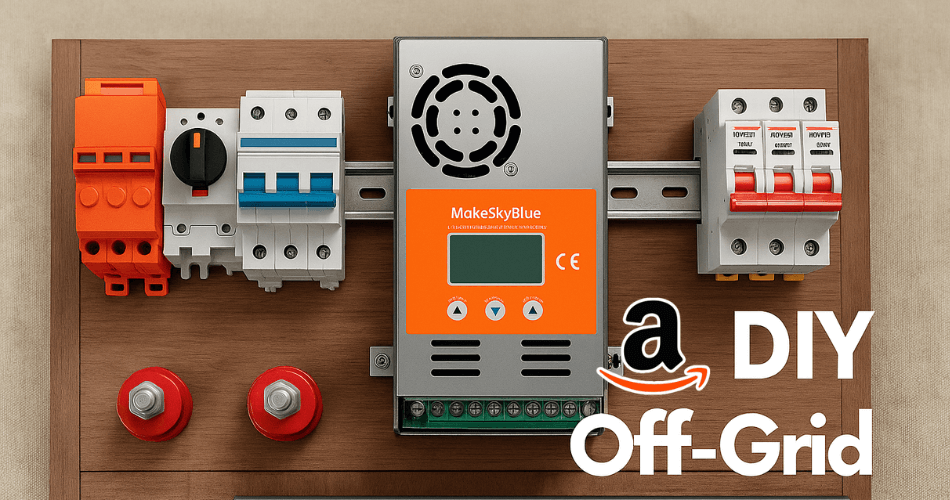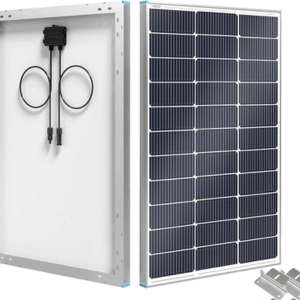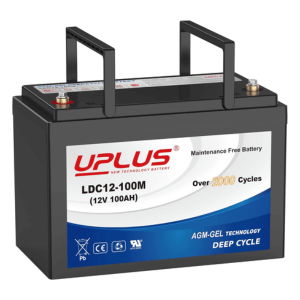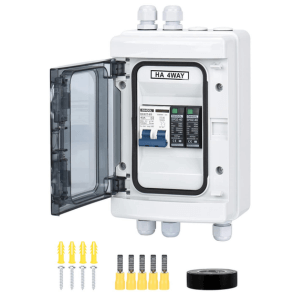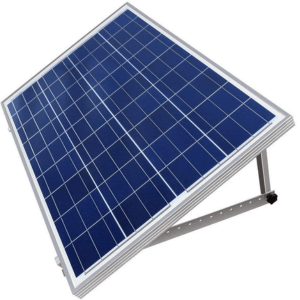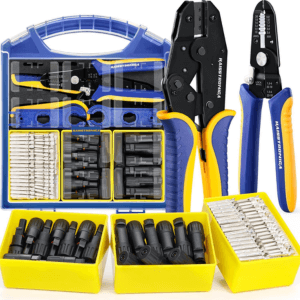If you’ve ever dreamed of powering your cabin, RV, boat, or tiny home without relying on the grid, then an off-grid solar setup might be exactly what you need. With the right combination of solar panels, charge controllers, inverters, and batteries, you can generate your own clean, renewable energy — anywhere the sun shines.
Now, when it comes to sourcing reliable equipment, Amazon is a goldmine. You’re not only getting access to trusted brands and fast shipping, but also the benefit of reading through thousands of real customer reviews before making a decision. Whether you’re putting together your first small-scale solar project or upgrading an existing system, you’ll find nearly every essential component in one place.
Table of Contents
In this guide, we’ll walk through the key products you’ll need for a DIY off-grid solar build, highlighting options that balance performance, durability, and value for money. From rugged solar panels to intelligent charge controllers, these are Amazon finds that can help you bring your energy independence project to life.
System Specifications
Before diving into the components, let’s outline the type of off-grid solar system we’re building. This example setup is designed to be both beginner-friendly and scalable, making it suitable for small cabins, RVs, boats, or as an emergency backup power solution.
- System Type: 24V Off-Grid Solar Power System
- Solar Panel Capacity: 1200W (expandable)
- Battery Bank: 200Ah Deep Cycle (expandable)
- Charge Controller: MPPT type for higher efficiency
- Inverter: Pure sine wave, 3000W continuous output
- Usage Case: Lighting, small appliances, charging electronics, running a small fridge, and other low-to-medium power needs
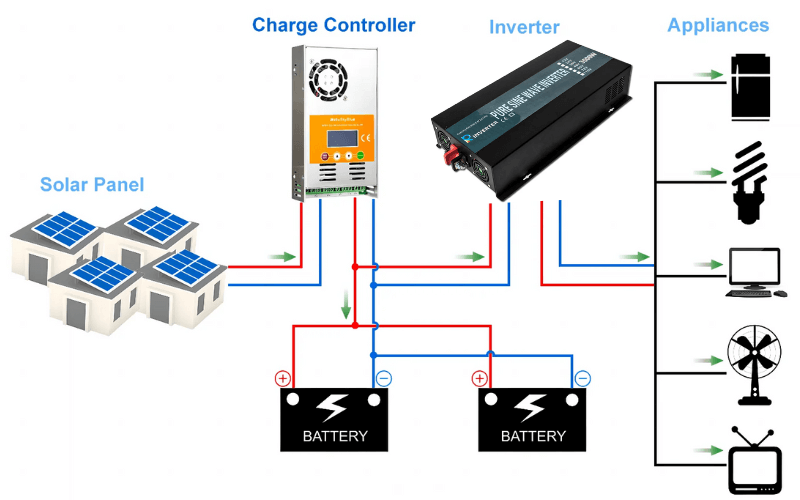
This configuration strikes a good balance between affordability, ease of installation, and real-world usability. The idea is to start with a reliable 400W solar array and enough battery storage to keep your essentials running, while leaving room to add more panels or batteries later. All the products mentioned in the following sections are readily available on Amazon from well-reviewed, reputable brands
1. Solar Panels
When building an off-grid solar system, the solar panels are your powerhouse — literally. They’re the first link in the chain, converting sunlight into usable electricity. On Amazon, you’ll find a wide selection of panels from trusted brands like Renogy, Rich Solar, and Newpowa, all of which have solid reputations among DIY solar enthusiasts.
For this setup, we’re going with 1200W of total solar capacity, which can be achieved with six 200W monocrystalline panels. Monocrystalline panels tend to have a higher efficiency rate than polycrystalline ones, meaning they can produce more power in a smaller footprint — a big advantage if you’re mounting them on an RV roof or a compact frame.
One of the benefits of shopping for panels on Amazon is the ability to compare hundreds of reviews. For instance, many users mention that these panels maintain strong output even on slightly overcast days, and they come with pre-drilled holes for easy installation. If you expect to expand your system later, it’s smart to choose panels that are easy to wire in series or parallel. Many Amazon listings include complete wiring diagrams and compatibility charts so you can match future additions without headaches
If you expect to expand your system later, it’s smart to choose panels that are easy to wire in series or parallel. Many Amazon listings include complete wiring diagrams and compatibility charts so you can match future additions without headaches
2. Charge Controllers (MPPT)
If the panels are the muscles of your system, the charge controller is the brain. It takes the raw juice from your solar array, finds the sweet spot (maximum power point), and feeds your batteries the right amount of energy — safely and efficiently.
I always recommend an MPPT controller over PWM for off-grid setups. Why? MPPTs routinely squeeze 10–30% more charging power out of the same panels, especially in early morning, late afternoon, or cloudy conditions. For a 1200W / 24V build, a 60A MPPT gives you comfortable headroom; for bigger arrays you can step up to 60A or more.
What to look for
Pick a controller that includes these practical features (they matter once you start installing and using the system):
- Battery type support (sealed lead-acid, gel, AGM, lithium) so you can choose or upgrade batteries later.
- Temperature compensation to protect and optimize charging in hot/cold climates.
- Clear LCD or app monitoring so you can see volts, amps, SOC, and charging status at a glance.
- Electronic protections — over-voltage, over-temperature, reverse polarity/short-circuit, and output current limiting.
- Auto voltage detection (12/24/48V) if you want flexibility across systems.
- Helpful wiring diagrams and installation notes in the listing.
Brands & a budget pick
On Amazon, Renogy, Victron Energy, and EPEVER are the go-to names for reliable MPPTs — solid builds, good firmware, and strong customer support. Pricewise, these are mid-range to premium units (more features, better monitoring).
If you’re on a tight budget, MakeSkyBlue is a popular grab — a true budget contender that performs surprisingly well. It often matches core performance specs (MPPT tracking, multi-battery support, low self-consumption) and is available in larger current ratings (eg. 60A variants). Example specs commonly advertised for MakeSkyBlue models include:
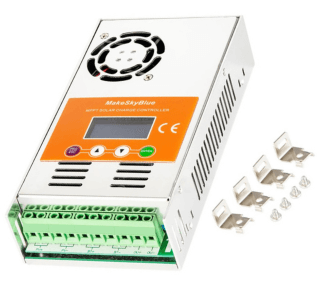
MakeSkyBlue MPPT Charge Controller
- Input – Auto detect 12, 24 & 48V
- Current Rating – 60A
- Max PV Power(24V) – 1440W
- Efficiency: claims above ~98% and very low self-consumption (~1–2W)
One caveat with MakeSkyBlue: some users report audible fan noise on certain models — not a reliability issue, but something to consider if you’re mounting your controller inside a living space or a small shed.
Value tip: MPPT controllers cost more upfront than PWM, but on Amazon the price gap has narrowed. For almost any real off-grid use, MPPT is worth it — more usable energy, better battery health, and smoother system operation.
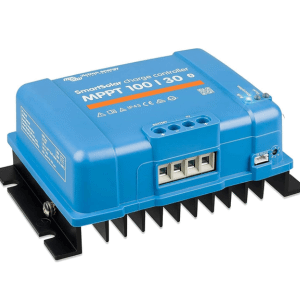
Victron MPPT
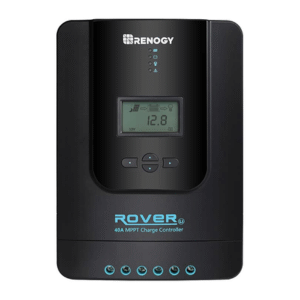
Renogy Rover 40A MPPT
3. Batteries
Your solar panels might be generating the power, but the batteries are what actually store it for later — and when you’re off-grid, that stored energy is your lifeline. Choosing the right battery bank is one of the most important decisions in your build, both in terms of performance and long-term cost.
For our 12V, 400W PV system, a 200Ah deep-cycle battery bank is a solid starting point. This gives you enough storage for lighting, electronics, and small appliances overnight or on cloudy days, without overspending at the beginning. And since you can always expand, you don’t need to overbuild on day one.
Battery Types to Consider on Amazon
1. AGM / Gell Lead-Acid
- Affordable, maintenance-free, sealed (no risk of spills), works well in various orientations.
- Extremely low self-discharge, handles deep discharge better than standard AGM, good for infrequent use (e.g., vacation cabins).
- Heavier, shorter lifespan than lithium, lower usable capacity (don’t discharge below ~50% regularly).
3. Lithium Iron Phosphate (LiFePO₄)
- Pros: Much lighter, higher usable capacity (80–90%), thousands of cycles, fast charging, holds voltage well under load.
- Cons: Higher upfront cost, needs a compatible charge profile, can’t charge below freezing without built-in heating.
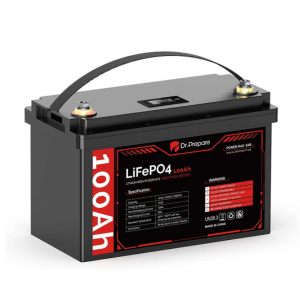
DR.PREPARE 12V 100Ah LiFePO4 Battery

ECO-WORTHY 12V 100AH LiFePO4 Lithium Battery
Extra Tips for Amazon Buyers
- BMS (Battery Management System): Many lithium batteries on Amazon come with an integrated BMS — essential for protecting against overcharge, over-discharge, and short circuits.
- Modular Expansion: If you plan to expand, choose a brand/model with good parallel connection support and clear wiring guidance.
- Weight & Shipping: Amazon shows exact product weights — this matters if you’ll be moving your batteries often or mounting them in a weight-sensitive space like an RV.
- Temperature Ratings: Check listings for recommended operating and storage temperatures, especially if your system will be exposed to seasonal extremes.
Value Tip: While lithium batteries are more expensive, their long lifespan and higher usable capacity often make them the better investment over time. If budget is tight, starting with AGM and upgrading later is a perfectly valid path — just size your system with that future swap in mind.
4. Inverter
Your panels generate DC power, your batteries store DC power — but most household devices want AC power. That’s where the inverter steps in, converting your stored energy into a form your appliances can use.
For a small to mid-sized off-grid system like our 400W setup, a pure sine wave inverter is the way to go. It delivers clean, stable power, safe for sensitive electronics like laptops, LED TVs, and medical equipment. Modified sine wave inverters are cheaper, but they can cause buzzing in devices, reduced efficiency in appliances, and even damage over time to sensitive gear — not worth the risk.
Sizing Your Inverter
For general off-grid living with lights, fans, a small fridge, and electronics, a 2000–5000W pure sine wave inverter is a good range. This gives you enough capacity for startup surges from appliances without oversizing (which can waste energy in idle consumption). If you plan to run power tools or larger appliances, consider stepping up atleast to 3000W or more.
Recommended Features to Look for on Amazon
- Low idle power draw — important for preserving battery life when nothing is running.
- Built-in safety protections — over-voltage, low-voltage cutoff, overload, short circuit, and over-temperature shutoff.
- Remote control or monitoring — lets you turn the inverter on/off without going to the unit.
- Strong peak/surge rating — ideally 2x the continuous rating for motor-starting loads.
- AC outlets & USB ports — for direct plug-in without extra adapters.
Amazon-Available Options
Many Amazon listings include real-world user feedback on noise levels, idle draw, and surge performance. These reviews can be gold — you’ll often find tips on which appliances run smoothly, what kind of cabling works best, and any quirks to watch out for.

GIANDEL Pure Sin Wave Inverter
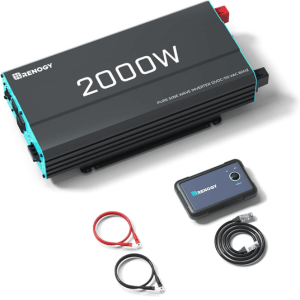
Renogy 12V to 110V Pure Sine Wave Inverter
Value Tip: Don’t overspend on wattage you’ll never use. A well-matched inverter will run cooler, waste less energy, and last longer. It’s better to size for your current needs plus a small cushion than to buy a massive inverter that idles away precious battery capacity.
Protection Devices & Other Necessary Components
When building an off-grid solar system, the big-ticket items get all the glory — panels, batteries, and inverters — but trust me, the unsung heroes are the protection devices and the smaller but vital accessories. Skimp on these, and even the best system can face early failures, unsafe operation, or costly downtime.
Let’s start with circuit breakers and fuses. These are your system’s first line of defense against overloads and short circuits. A DC-rated breaker between the solar panels and the charge controller prevents high-voltage DC arcs from causing damage during maintenance or unexpected faults. Similarly, fuses at critical points — especially between the battery bank and inverter — can stop dangerous currents from turning your investment into smoke.
Next up: surge protection devices (SPDs). If you live in an area prone to lightning strikes or sudden grid surges (yes, even an off-grid cabin can get affected via long DC cable runs), these small units can save thousands in replacement costs. A good SPD between the solar array and the controller can prevent transient voltage spikes from frying your expensive electronics.
Battery management and monitoring tools are another must. Even if your charge controller provides basic monitoring, adding a dedicated battery monitor like the Victron BMV-712 or a budget-friendly alternative from AliExpress can give you precise insight into voltage, current, and state-of-charge. Knowing your battery’s actual health means you can prevent over-discharge, one of the fastest killers of lead-acid and even lithium packs.
Don’t forget bus bars and proper cabling. High-current connections demand solid copper bus bars to keep wiring neat and voltage drop to a minimum. Pair them with appropriately sized cables and quality lugs — preferably crimped with a hydraulic crimper — for a low-resistance, long-lasting connection.
And then there’s the earthing/grounding system. In off-grid setups, proper grounding not only improves safety but also reduces electrical noise in sensitive electronics.
Mounting — Stability Meets Safety
Whether you’re installing on a roof, a pole, or a ground frame, sturdy mounting is non-negotiable. Your panels will be fighting wind, rain, and the occasional curious animal for years — so flimsy brackets just won’t do. On Amazon, you can find adjustable tilt mounting kits like the Renogy Adjustable Solar Panel Mount Brackets or heavy-duty IronRidge Roof Mount Kits for more permanent setups. Tilt adjustment is a bonus if you want to tweak panel angles seasonally for maximum output.
Small Extras That Make a Big Difference
- MC4 connectors and branch connectors (HQST MC4 Kit) for clean, weatherproof panel connections.
- Heat shrink tubing and cable glands to keep moisture out and wiring neat.
- Labeling tape or heat shrink markers — future-you will thank present-you when troubleshooting.
Value vs. Price
While you can save money on Amazon with lesser-known brands, I strongly suggest not skimping on wiring and protection devices. A budget panel or controller might just mean slightly less efficiency — but cheap, low-quality wiring or fuses can take your whole system down in seconds. Think of these components as your solar system’s immune system: you don’t notice them much, but when something goes wrong, they’re the ones saving the day.
System Upgrades: Expanding Your Off-Grid Power Without Starting Over
One of the most rewarding parts of building your own off-grid system is that it doesn’t have to stay frozen in time. Life changes — maybe you’ve bought a bigger fridge, started running a power-hungry water pump, or just want the luxury of brewing coffee and running the AC at the same time. The good news? If you’ve chosen the right components from the start, upgrading becomes more like adding puzzle pieces than rebuilding from scratch.
The key is scalability. When buying your core components — inverter, charge controller, and battery bank — go for models that can handle a little more than your current needs. Many quality Amazon-listed pure sine wave inverters are stackable, meaning you can connect a second one in parallel to double your output. Same goes for MPPT charge controllers; if you pick a unit with a higher PV input limit, adding more solar panels later is a breeze.
Upgrading the battery bank is often the most impactful move. Let’s say you started with a 200Ah LiFePO₄ bank from a trusted Amazon seller — you can simply add another identical battery in parallel to double your storage. Just remember, mixing battery types or different ages is a recipe for imbalance. Keep it uniform for best performance and lifespan.
Solar panel expansions are straightforward too, provided your wiring and breaker ratings can handle the increased current. I always recommend leaving a little headroom in your cabling capacity and fuse sizes for future growth — it’s a tiny extra cost now that saves a lot of rework later.
Another often-overlooked upgrade? Smart monitoring systems. Many modern inverters and MPPT controllers on Amazon come with Wi-Fi or Bluetooth modules that let you track real-time production and usage from your phone. It’s not just a tech toy — it helps you understand your consumption habits and optimize panel placement, tilt, or load scheduling.
In short: design with the future in mind. The off-grid journey isn’t about perfection on day one — it’s about building a reliable base that grows with you. And thanks to the massive selection of reliable, brand-backed components on Amazon, you can scale up with confidence, knowing you’re adding parts that fit seamlessly into your existing system.
Closing Thoughts: Powering Your Off-Grid Dream the Smart Way
Setting up an off-grid solar system isn’t just about throwing some panels on the roof and hoping for sunshine—it’s about creating a reliable, efficient, and cost-effective power source you can count on, day and night, year after year. By choosing well-reviewed Amazon products, you’re not only tapping into competitive pricing and fast shipping, but you’re also buying into the peace of mind that comes with thousands of customer experiences at your fingertips.
💡 On a tighter budget? Amazon offers speed and convenience, but if you don’t mind longer shipping times, AliExpress can save you even more on off-grid solar parts. For a full step-by-step guide, check out our DIY Off-Grid Solar Setup with AliExpress Products
Here’s what I’ve learned after years of tinkering with off-grid setups:
- Don’t chase the cheapest gear blindly. A low upfront price might be tempting, but replacing a fried inverter or dead battery bank mid-season is far costlier. Balance affordability with brand reputation and verified reviews.
- Plan for tomorrow, not just today. If you think you’ll expand your system later—add more panels, increase storage, or upgrade appliances—choose components that are scalable from the start.
- Read beyond the star ratings. Some products look great at 4.8 stars, but the truth often hides in the mid-star reviews (the 3’s and 4’s). They tell you the quirks, the small frustrations, and the long-term issues.
- Keep spares for critical components. A spare MC4 connector, extra fuse, or backup charge controller can save you days (or weeks) if a part fails. Amazon makes stocking these small parts easy.
